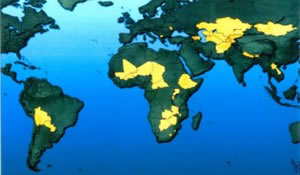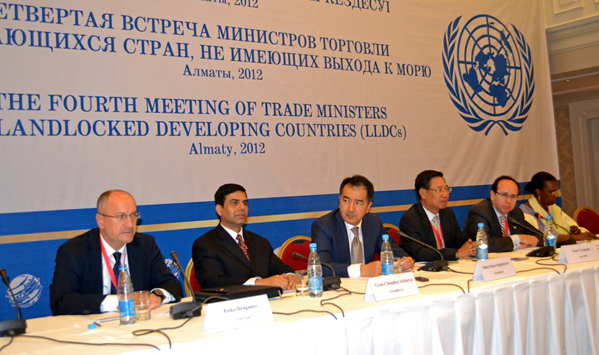Mr. Draganov went on to say that for the 31 LLDCs, the promotion of efficient transport systems is an important objective, but these efforts must not stop at their countries’ borders. Many investments in transport and trade facilitation infrastructure need to be cross-border in nature and hence close cooperation between LLDCs and their transit countries is a sine qua non for improved cross-border transport connectivity of LLDCs.
Noting that LLDCS as a group have recorded impressive trade performance in the recent past, with total exports increasing almost fivefold between 2000 and 2010, Mr. Draganov cautioned that the share of the group in global tgrade is still modest and amounted to only 1.04 per cent in 2010. Moreover, the LLDCs’ exports are concentrated in a few countries and in a few products. Six countries — Azerbaijan, Botswana, Kazakhstan, Paraguay, Turkmenistan, and Uzbekistan accounted for 70 per cent of LLDC merchandise export.
In terms of products, the external trade of LLDCs continues to be highly concentrated in a few primary commodities — crude oil and natural gas, minerals and metals.

“This broad picture of the value and composition of the external trade of the LLDCs underlines the need for continued international assistance to these countries to advance structural transformation and economic re-specialization“, Mr. Draganov told the Meeting.
He went on to say that the preparatory process for the Comprehensive Ten-Year Review Conference of the 2003 Almaty Programme of Action should be used as an opportunity to develop a bold vision for the future.
In addition to transit policy issues in a successor document to the Almaty PoA, UNCTAD would like to see emphasis on strong regional cooperation and integration and an economic specialization that takes into account constraints related to the specific geographical location of LLDCs, and for them to grow from being land-locked into being land-linked and air-linked.
Development policies need to go hand in hand with efforts to attract FDI to economic sectors that produce goods and services that are less sensitive to distance or transport costs, Mr. Drganov said. LLDCs should promote production of high-value but low-bulk goods, such as high-precision instruments, IT components and pharmaceuticals, as well as services in areas such as tourism, education and ICTs. In export agriculture, LLDCS should target high-end crops, such as cut flowers, off-season fruits and vegetables or organic products, that lend themselves to expeditious and cost-efficient air transport.
Other issues listed by the UNCTAD Deptuy Secretary-General as emerging challenges and opportunities for LLDCs included: South-South and triangular cooperation, building productive capacities for economic diversification, promoting “green” economic activities and use of clean technologies, mitigating climate change, emigration and brain drain, accession to WTO, and ensuring more benefits for LLDCs from the Aid for Trade initiative.
- Mr. Acharya, USG and High Representative for LDCs, LLDCs and SIDS
- Mr. Bakytzhan Sagintayev, Minister of Economic Development and Trade of the Republic of Kazakhstan
- Mr. Dr. Nam Viyaketh, Minister of Industry and Commerce, LAO PDR
- Mr. Manuel Maria Caceres, Vice Minister of External Affairs and Economic Issues, Paraguay
- Ms. Valentine Rugwabiza, Deputy Director-General, WTO



